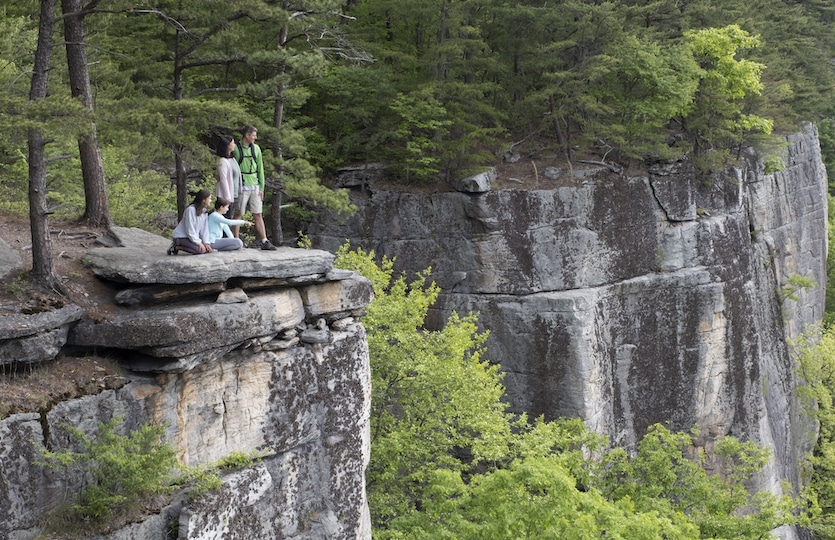
Family admiring the view along the Endless Wall Trail inside West Virginia’s New River Gorge National Park. Photo by Charles Cecil
By Chuck Cecil
America’s newest National Park in West Virginia’s New River Gorge offers an enticing reason to discover the Appalachian Mountains. Railroads, coal mining, and logging were the original engines of growth in this frontier area of America, which opened to settlement only in the late 1700s. By the beginning of this century, these industries were all in decline and the area was transitioning to a new phase of economic growth.
The new New River Gorge National Park, which opened in December 2020, is a significant contributor to this transition. But once you’re there, you’ll find West Virginia has a surprising number of interesting historical and scenic attractions.
Not only that; it’s surprisingly accessible. The closest international airport is in Charlotte, North Carolina. It receives non-stop flights from London, Frankfurt, and Munich. One-stop connections via Washington-Dulles, Atlanta, or JFK are numerous. Once you’re in Charlotte it’s a 3-4 hour drive to Fayetteville, the northern gateway to the park, but there are other interesting destinations worth seeing along the way. Atlantic Coast residents with a car can drive to the park in five hours from Washington, seven from Atlanta, or eight and a half from New York.
The New River is a sinewy, untamed river flowing through a mountainous, forested area of the state, unusual in that it flows northwards. About 53 miles of river are within the park and the larger protected area around the park itself. The park offers an assortment of recreational opportunities, including hiking, mountain biking, rock climbing, white-water rafting, and kayaking. Accommodations are available in small communities surrounding the park, plus a wide variety of cabin and camping facilities.
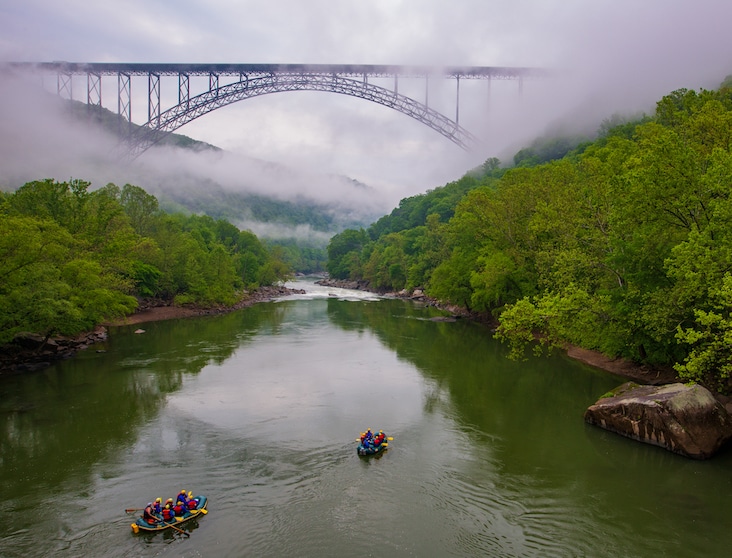
West Virginia’s New River has plenty of rapids, but as rafters approach the New River Gorge Bridge the water calms long enough to enjoy the beautiful surroundings. Photo by Eric Lindberg
The New River Bridge, carrying U.S. highway 19 across the river between Fayetteville and Lansing was the highest and longest single-span arch bridge in the world when it was completed in 1977. It has since been surpassed but remains the longest steel span in the Western Hemisphere. Tourists, harnessed in for safety, can walk across it on a catwalk 25 feet underneath the road surface above.
About 1.4 million people visited the New River Gorge and two other scenic areas nearby in 2019, according to the park service. More are expected in the post-COVID era.
The park offers four visitor centers. Unlike most national parks, no entry fee is charged at New River Gorge. Visitors arriving from the north will stop at the Canyon Rim Visitor Center on U.S. Route 19, just before the bridge. Coming from the south the Sandstone Visitor Center would be your entry point. These are the places to get your trail guide maps and info for the more than 100 miles of hiking, mountain bike, and equestrian trails within the park. (Eighteen trails are designated to permit mountain bike use.)
Canyon Rim also provides views of the bridge spanning the gorge, plus views of the gorge itself. Accommodations are available at several locations on the north side of the river (I stayed at Adventures on the Gorge), with even more choices on the south side in and around Fayetteville.
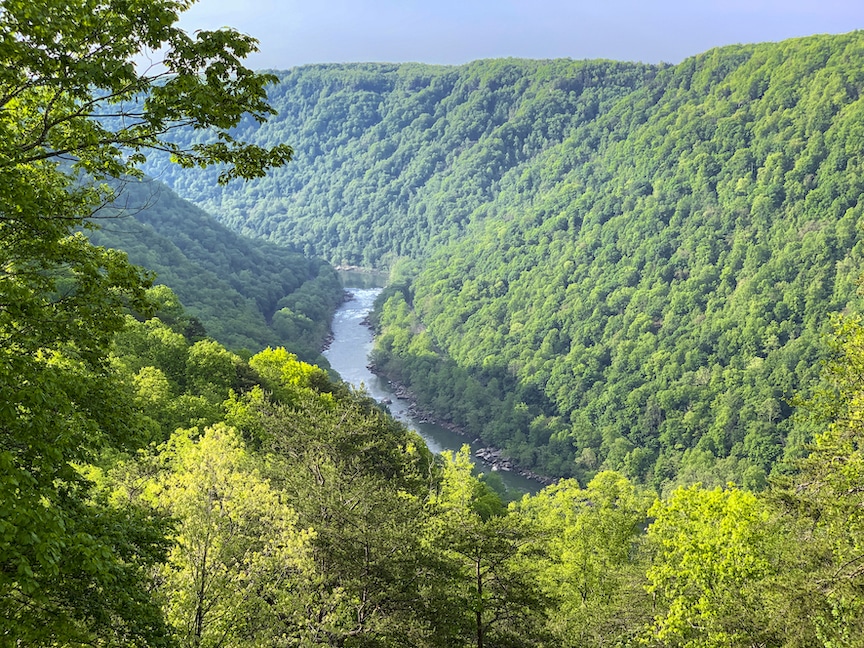
New River Gorge as seen from the National Park Visitor Center. Photo by Charles Cecil
I began my visit by hiking the Endless Wall Trail, a moderate 2.5 miles, offering numerous views of the gorge and sandstone cliffs along the route. After crossing Fern Creek on a wooden bridge, the trail rises gently, passing through stands of Catawba rhododendrons (pink-purple in mid-May, white in July) and a variety of mixed hardwood forest cover. Diamond Point offers one of the best views of the exposed rock walls of the gorge with the river some 800-1000 feet below. Along the way you pass access points to popular rock-climbing sites considered by the park to be “some of the best rock climbing in the eastern United States.” Cliffs along the endless wall offer climbs from 30 to 120 feet in height, most of which are deemed appropriate for advanced, experienced climbers.
Near the Canyon Rim visitor center West Virginia state highway 82 leads down into the gorge to the old one-way Tunney Hunsaker bridge over the river that locals had to use before the new bridge was completed in 1977, reducing the 40-minute drive between Lansing and Fayetteville to 1-2 minutes. Pedestrians can walk across the old bridge, which affords scenic views of the river and of the new bridge from down below.
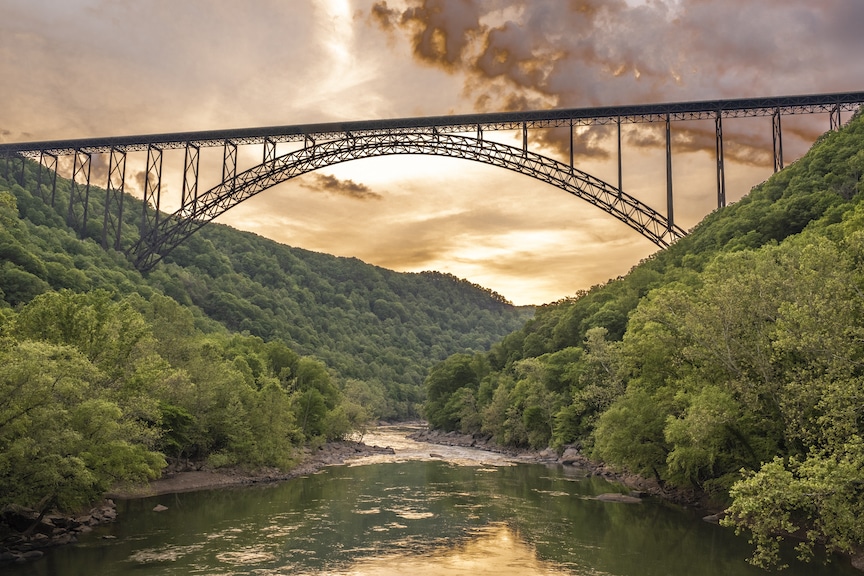
Because of the early morning blanket of fog, the best time to take a photo of the New River Gorge Bridge is often in the late afternoon. Photo by Charles Cecil
Early risers may want to follow state highway 9 out of Fayetteville to Kaymoor Road and the trailhead to the Kaymoor Miners trail on the south side of the river for beautiful morning sunrises. When I visited in May weather conditions filled the gorge with morning fog, adding a special quality to views of the gorge.
Midway between the two visitor centers is the Grandview Information Station (open June through August) offering panoramic views of the gorge and the river 1,400 feet below. Seven trails start in this area.
Anyone coming far enough to see New River Gorge should consider staying another two to three days to see other historical attractions within an hour and a half drive of the park. Beckley, midway between the two main visitor centers, should be among your stops. The town is home to the Beckley Exhibition Coal Mine, which was a commercially active coal mine from 1905 until 1953. The city subsequently bought the site, dedicating it to educating the public about coal mining and the life of miners’ families.
Coal mine tours (April 1-November 2) are led by former coal miners from other mines and provide a vivid account of a typical Appalachian miner’s daily work routine. Also on the site are a restored single-room dwelling for a single coal miner, a church, a coal camp schoolhouse, and the reconstructed house for the mine’s English superintendent, built to resemble houses in the English countryside where he was born.
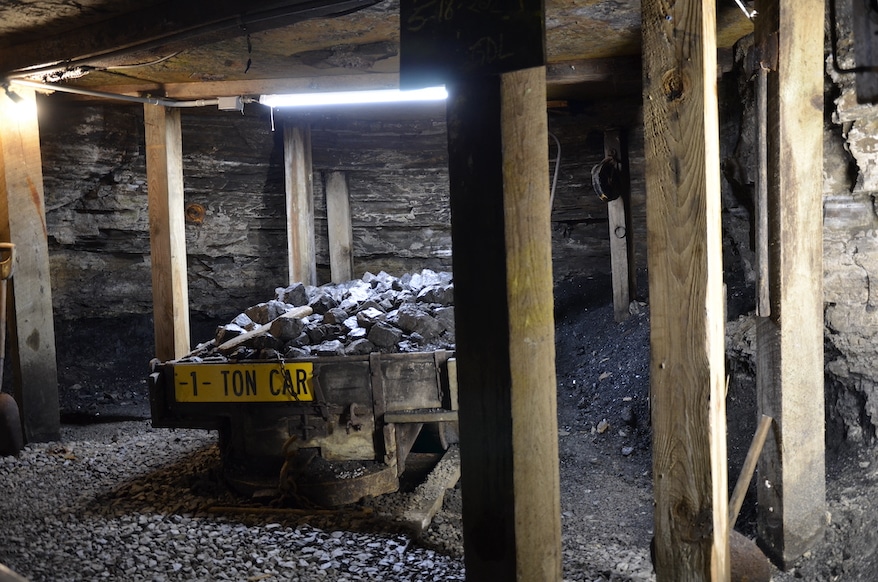
The Beckley coal mine no longer is active because extraction is not commercially viable. Plenty of coal remains, however, and if you ask the miner on duty probably will let you take home a chunk. Photo by David DeVoss
Also at Beckley, just off Interstate 77, is the Tamarack Marketplace, a showcase of Appalachian arts and crafts. The center displays the work of 2,800 artists and artisans from all over the state, an impressive demonstration of West Virginia talent. It also offers dining options, making this a convenient stop before or after the coal mine tour.
Sandstone Visitor Center, near the southern end of the park, is less than 20 miles or 25 minutes from Beckley. The center is open in spring, summer, and fall. This is the site of the largest waterfall on the New River. Though the river only drops some 25 feet, it is 1500 feet wide at Sandstone Falls, divided by a series of islands. A fully-accessible boardwalk leads across the islands to viewing points. The Falls mark the transition zone from broader, flat land into a narrow mountain V-shaped gorge.
Over the next 53 miles the river will fall 750 feet, creating class I to III rapids north to Thurmond, increasing to class IV and V as it passes through the northern portion of the park. Whitewater rafting is no doubt the most exciting way to explore the New River Gorge. Most whitewater outfitters are located in and around Fayetteville. They offer half-, full- and multi-day trips, from May through October. Children as young as six are accepted on the southern portions of the river, but the more dramatic northern section is limited to ages eleven and above.
Travelers unhindered by budgetary considerations might want to overnight at The Greenbrier resort at White Sulphur Springs. Hoteliers have been receiving guests at this location since 1778. Twenty-eight US presidents have visited, plus many international celebrities and royalty. The current facility opened in 1913 but was completely modernized and refurbished after World War II, re-opening in 1953 after being redecorated in a luxurious classical style featuring bold colors and floral decorations, all now immaculately maintained.
This five-star resort caters to golf aficionados but also offers a wide variety of recreational activities: a mineral spa, several restaurants and boutique shops, and an in-house casino. Drivers coming from East Coast starting points or driving up from Charlotte might find The Greenbrier a convenient stopping point en route to New River Gorge. If the Greenbriar is beyond your budget, more affordable accommodation options are available at Beckley, an hour or less away.

Never know who you’ll meet in the bar at the Greenbrier. Photo by David DeVoss
It isn’t necessary to overnight at The Greenbrier to see “The Bunker,” an amazing relic of the Cold War era. Built during the Eisenhower administration, this top secret underground facility was maintained in ever-ready status for thirty years, ready to house the U.S. Senate and House of Representatives in case of an unexpected foreign attack. Members of Congress were allowed one staff aide apiece with them in the bunker. Spouses could not enter the bunker but could be accommodated above ground in a new wing whose construction was explained as part of a Greenbrier effort to attract more conventions and exhibitions. On May 31, 1992, a Washington Post story revealed the facility’s location and purpose. Deprived of secrecy, the bunker was phased out of use by 1995. Tours are offered today by the Greenbrier for visitors ten years of age and older. (Reserve tickets online in advance.)
Those interested in more of West Virginia’s history might also want to make the twelve-mile jog south of the Sandstone Visitor Center to Hinton, the southern gateway to the park. Placed on the National Register of Historic Places in 1984, the Hinton historic district contains more than 200 buildings within a 24-block area. The Chesapeake and Ohio Railroad purchased the land now occupied by Hinton in 1871, intending to make the location a regional maintenance center for its operations. Rail lines were laid through the New River Gorge (still in use today), offering the easiest route over the most difficult terrain of the Appalachian mountains for people heading to the Ohio River. The C&O began selling town lots in 1874. The town reached 6000 inhabitants by 1906, and 8000 by 1925. The Hinton Railroad Museum displays many exhibits and artifacts related to the role of the railroad in stimulating the economy and population growth of the region.
There is no shortage of other historical and recreational destinations within an easy drive of the national park. Lewisburg, just ten miles from White Sulphur Springs, offers art galleries, antique and specialty shops, and the North House Museum, an 1820 residence where one can see the fifth oldest quilt in the United States, plus information about the daily life of a free Black family in West Virginia prior to the Civil War.
South of Hinton, Bluestone State Park and the Bluestone National Scenic River offer outdoor recreational activities.
North of the Canyon Rim Visitor Center, the Gauley River National Recreation Area offers Class V rapids for the truly experienced kayakers and rafters (minimum age 16). Thousands of whitewater enthusiasts come to the Gauley every fall season, to paddle what is considered by many to be one of the best whitewater rivers in the country. The season begins the first weekend after Labor Day (early September), and continues for six weekends (five 4-day weekends, and one 2-day weekend).
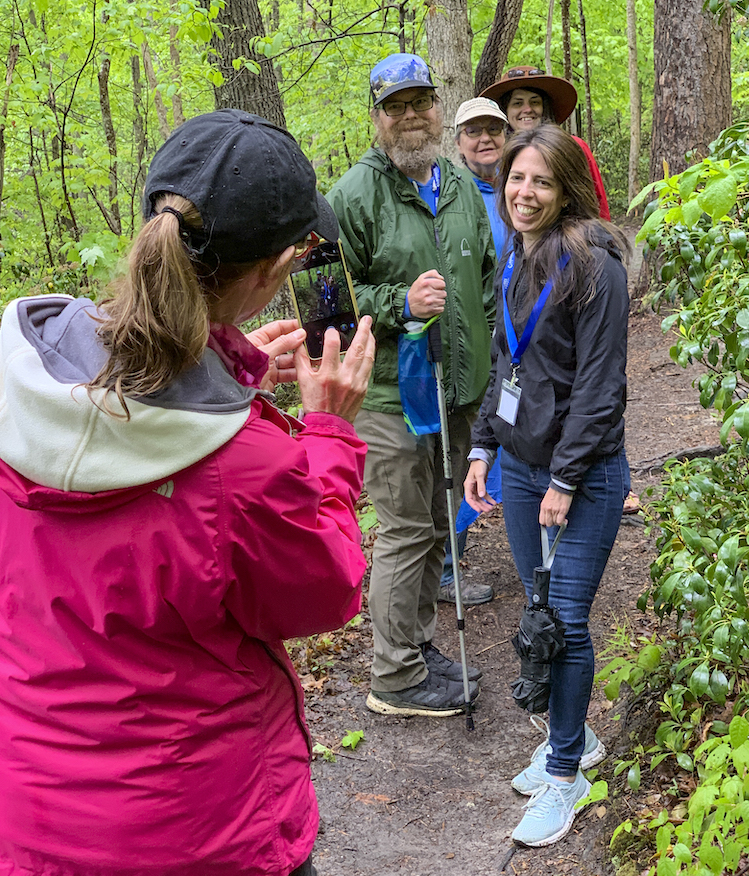
West Virginia, Hikers on the Endless Wall Trail inside the New River Gorge National Park pause for a photo Op. Photo by Charles Cecil
A short drive east of the Canyon Rim center, just off U.S. highway 60, is Babcock State Park, site of a reconstructed grist mill typical of those once found throughout the state.
The creation of the New River Gorge National park is sure to draw many more visitors to this area of West Virginia. More visitors will lead to the development of more accommodations and new attractions. The park will provide a needed boost to the region as the mining and timber industries give way to new opportunities.
East-West News Service photographer Charles Cecil spent 36 years in the U.S. Foreign Service, ending as U.S. Ambassador to Niger before deciding to devote himself to photography and writing. His previous stories for EWNS focused on Spain’s Camino de Santiago and the Maori of New Zealand.

